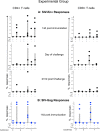Increased cellular immune responses and CD4+ T-cell proliferation correlate with reduced plasma viral load in SIV challenged recombinant simian varicella virus - simian immunodeficiency virus (rSVV-SIV) vaccinated rhesus macaques
- PMID: 22889373
- PMCID: PMC3485174
- DOI: 10.1186/1743-422X-9-160
Increased cellular immune responses and CD4+ T-cell proliferation correlate with reduced plasma viral load in SIV challenged recombinant simian varicella virus - simian immunodeficiency virus (rSVV-SIV) vaccinated rhesus macaques
Abstract
Background: An effective AIDS vaccine remains one of the highest priorities in HIV-research. Our recent study showed that vaccination of rhesus macaques with recombinant simian varicella virus (rSVV) vector - simian immunodeficiency virus (SIV) envelope and gag genes, induced neutralizing antibodies and cellular immune responses to SIV and also significantly reduced plasma viral loads following intravenous pathogenic challenge with SIVMAC251/CX1.
Findings: The purpose of this study was to define cellular immunological correlates of protection in rSVV-SIV vaccinated and SIV challenged animals. Immunofluorescent staining and multifunctional assessment of SIV-specific T-cell responses were evaluated in both Experimental and Control vaccinated animal groups. Significant increases in the proliferating CD4+ T-cell population and polyfunctional T-cell responses were observed in all Experimental-vaccinated animals compared with the Control-vaccinated animals.
Conclusions: Increased CD4+ T-cell proliferation was significantly and inversely correlated with plasma viral load. Increased SIV-specific polyfunctional cytokine responses and increased proliferation of CD4+ T-cell may be crucial to control plasma viral loads in vaccinated and SIVMAC251/CX1 challenged macaques.
Figures




References
-
- Koff WC, Johnson PR, Watkins DI, Burton DR, Lifson JD, Hasenkrug KJ, McDermott AB, Schultz A, Zamb TJ, Boyle R, Desrosiers RC. HIV vaccine design: insights from live attenuated SIV vaccines. Nat Immunol. 2006;7:19–23. - PubMed
-
- Marthas ML, Miller CJ, Sutjipto S, Higgins J, Torten J, Lohman BL, Unger RE, Ramos RA, Kiyono H, McGhee JR. et al.Efficacy of live-attenuated and whole-inactivated simian immunodeficiency virus vaccines against vaginal challenge with virulent SIV. J Med Primatol. 1992;21:99–107. - PubMed
-
- Rerks-Ngarm S, Pitisuttithum P, Nitayaphan S, Kaewkungwal J, Chiu J, Paris R, Premsri N, Namwat C, de Souza M, Adams E. et al.Vaccination with ALVAC and AIDSVAX to prevent HIV-1 infection in Thailand. N Engl J Med. 2009;361:2209–2220. - PubMed
Publication types
MeSH terms
Substances
Grants and funding
LinkOut - more resources
Full Text Sources
Research Materials

